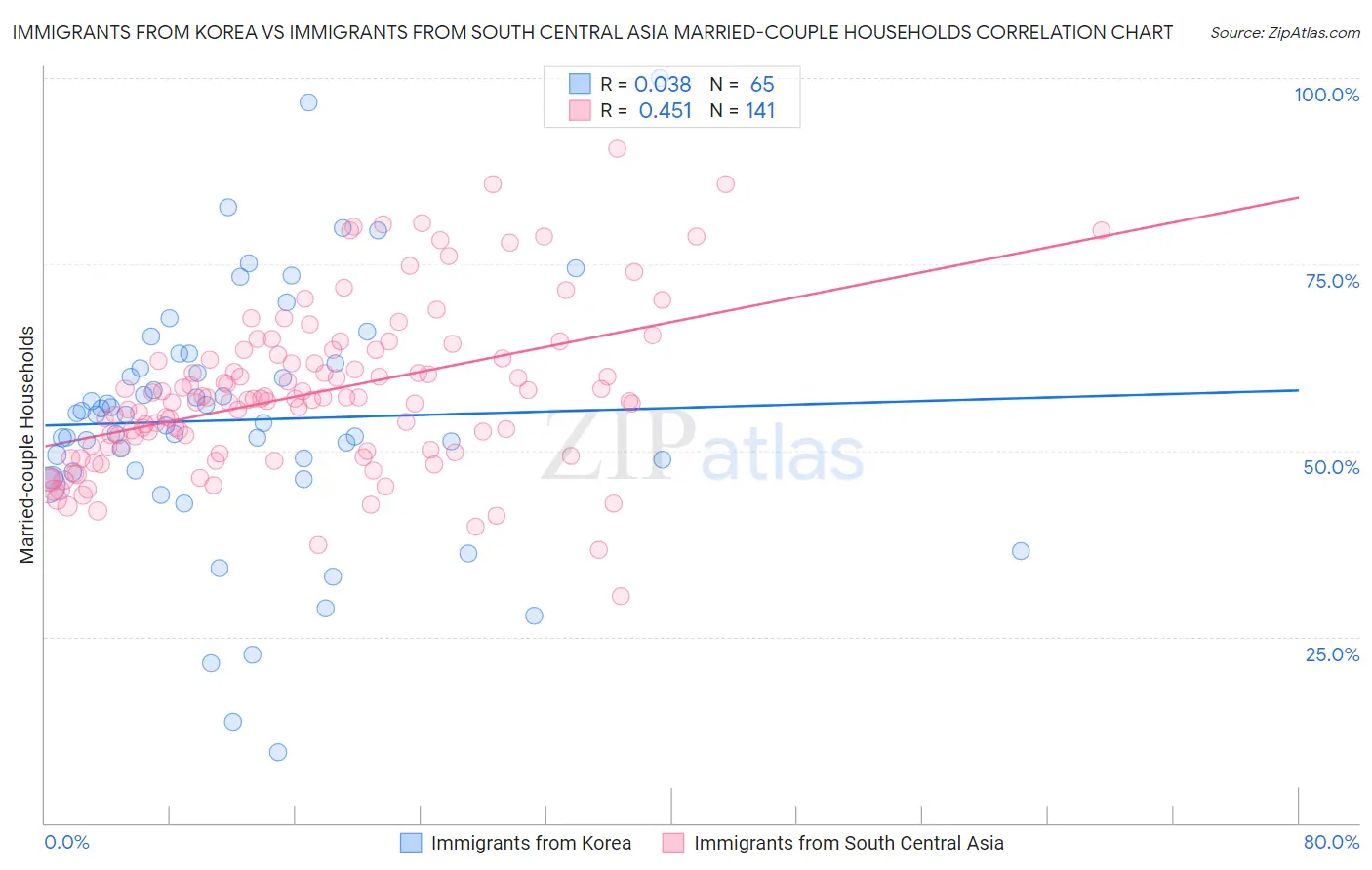Immigrants from Korea vs Immigrants from South Central Asia Married-couple Households
COMPARE
Immigrants from Korea
Immigrants from South Central Asia
Married-couple Households
Married-couple Households Comparison
Immigrants from Korea
Immigrants from South Central Asia
49.9%
MARRIED-COUPLE HOUSEHOLDS
100.0/ 100
METRIC RATING
13th/ 347
METRIC RANK
50.6%
MARRIED-COUPLE HOUSEHOLDS
100.0/ 100
METRIC RATING
8th/ 347
METRIC RANK
Immigrants from Korea vs Immigrants from South Central Asia Married-couple Households Correlation Chart
The statistical analysis conducted on geographies consisting of 415,948,029 people shows no correlation between the proportion of Immigrants from Korea and percentage of married-couple family households in the United States with a correlation coefficient (R) of 0.038 and weighted average of 49.9%. Similarly, the statistical analysis conducted on geographies consisting of 472,645,847 people shows a moderate positive correlation between the proportion of Immigrants from South Central Asia and percentage of married-couple family households in the United States with a correlation coefficient (R) of 0.451 and weighted average of 50.6%, a difference of 1.5%.

Married-couple Households Correlation Summary
| Measurement | Immigrants from Korea | Immigrants from South Central Asia |
| Minimum | 9.4% | 30.4% |
| Maximum | 100.0% | 90.5% |
| Range | 90.6% | 60.1% |
| Mean | 54.1% | 57.6% |
| Median | 54.9% | 56.9% |
| Interquartile 25% (IQ1) | 47.2% | 50.0% |
| Interquartile 75% (IQ3) | 61.4% | 62.5% |
| Interquartile Range (IQR) | 14.2% | 12.5% |
| Standard Deviation (Sample) | 16.7% | 10.8% |
| Standard Deviation (Population) | 16.6% | 10.8% |
Demographics Similar to Immigrants from Korea and Immigrants from South Central Asia by Married-couple Households
In terms of married-couple households, the demographic groups most similar to Immigrants from Korea are Burmese (49.8%, a difference of 0.13%), Swiss (49.9%, a difference of 0.17%), Korean (49.7%, a difference of 0.27%), Swedish (49.7%, a difference of 0.30%), and Immigrants from Hong Kong (49.6%, a difference of 0.46%). Similarly, the demographic groups most similar to Immigrants from South Central Asia are Pennsylvania German (50.4%, a difference of 0.55%), Chinese (50.4%, a difference of 0.55%), Filipino (51.0%, a difference of 0.64%), Danish (51.1%, a difference of 0.86%), and Immigrants from Pakistan (50.1%, a difference of 1.0%).
| Demographics | Rating | Rank | Married-couple Households |
| Immigrants | India | 100.0 /100 | #1 | Exceptional 52.7% |
| Immigrants | Taiwan | 100.0 /100 | #2 | Exceptional 52.4% |
| Thais | 100.0 /100 | #3 | Exceptional 51.9% |
| Assyrians/Chaldeans/Syriacs | 100.0 /100 | #4 | Exceptional 51.8% |
| Tongans | 100.0 /100 | #5 | Exceptional 51.6% |
| Danes | 100.0 /100 | #6 | Exceptional 51.1% |
| Filipinos | 100.0 /100 | #7 | Exceptional 51.0% |
| Immigrants | South Central Asia | 100.0 /100 | #8 | Exceptional 50.6% |
| Pennsylvania Germans | 100.0 /100 | #9 | Exceptional 50.4% |
| Chinese | 100.0 /100 | #10 | Exceptional 50.4% |
| Immigrants | Pakistan | 100.0 /100 | #11 | Exceptional 50.1% |
| Swiss | 100.0 /100 | #12 | Exceptional 49.9% |
| Immigrants | Korea | 100.0 /100 | #13 | Exceptional 49.9% |
| Burmese | 100.0 /100 | #14 | Exceptional 49.8% |
| Koreans | 99.9 /100 | #15 | Exceptional 49.7% |
| Swedes | 99.9 /100 | #16 | Exceptional 49.7% |
| Immigrants | Hong Kong | 99.9 /100 | #17 | Exceptional 49.6% |
| English | 99.9 /100 | #18 | Exceptional 49.6% |
| Europeans | 99.9 /100 | #19 | Exceptional 49.6% |
| Scandinavians | 99.9 /100 | #20 | Exceptional 49.6% |